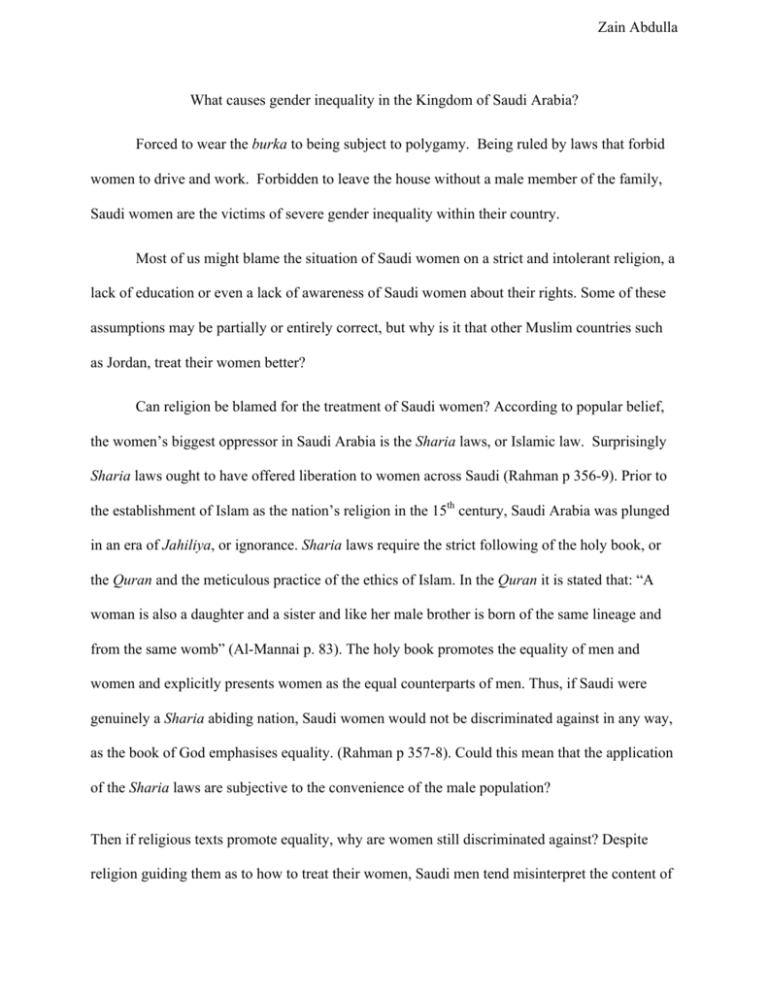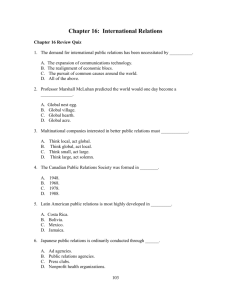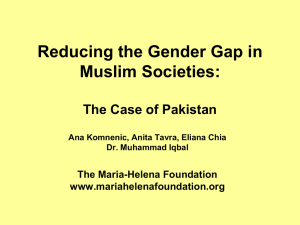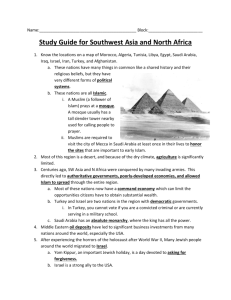What causes gender inequality in the Kingdom of Saudi Arabia
advertisement

Zain Abdulla What causes gender inequality in the Kingdom of Saudi Arabia? Forced to wear the burka to being subject to polygamy. Being ruled by laws that forbid women to drive and work. Forbidden to leave the house without a male member of the family, Saudi women are the victims of severe gender inequality within their country. Most of us might blame the situation of Saudi women on a strict and intolerant religion, a lack of education or even a lack of awareness of Saudi women about their rights. Some of these assumptions may be partially or entirely correct, but why is it that other Muslim countries such as Jordan, treat their women better? Can religion be blamed for the treatment of Saudi women? According to popular belief, the women’s biggest oppressor in Saudi Arabia is the Sharia laws, or Islamic law. Surprisingly Sharia laws ought to have offered liberation to women across Saudi (Rahman p 356-9). Prior to the establishment of Islam as the nation’s religion in the 15th century, Saudi Arabia was plunged in an era of Jahiliya, or ignorance. Sharia laws require the strict following of the holy book, or the Quran and the meticulous practice of the ethics of Islam. In the Quran it is stated that: “A woman is also a daughter and a sister and like her male brother is born of the same lineage and from the same womb” (Al-Mannai p. 83). The holy book promotes the equality of men and women and explicitly presents women as the equal counterparts of men. Thus, if Saudi were genuinely a Sharia abiding nation, Saudi women would not be discriminated against in any way, as the book of God emphasises equality. (Rahman p 357-8). Could this mean that the application of the Sharia laws are subjective to the convenience of the male population? Then if religious texts promote equality, why are women still discriminated against? Despite religion guiding them as to how to treat their women, Saudi men tend misinterpret the content of Zain Abdulla the Quran, and distort its meaning. (Syed et al p 72-3). Whether this distortion is voluntary or not, it has alarming consequences on the lives of Saudi women. For example, Saudi men will argue that the Quran says that women must wear the burka and therefore in the name of religion, force their women into the garment. However, nowhere in the holy book is it stated that a woman ought to be fully covered. Rather, it says that women ought to be decently dressed for the sake of their own self-respect and dignity. It is stated that women should “not to show their adornments except that of it which normally shows." (Dress Code for the Muslim women verse 7 sura 26 Holy Quran) According to a study carried out by CNN’s Mansoor Moaddel, “Nearly two out of three people in Saudi Arabia believe women should keep everything but their eyes covered when they are in a public place” Moaddel however went on to conclude that “at the same time, nearly half say it is up to a woman to dress however she wants.” These figures show us a significant contradiction between the desire to retain ultra conservative values and at the same time enable the woman to make her own choice. These statements also do not add up and are confusing from the perspective of an outsider, because it seems as though Saudi men believe both things yet in practice, do not given women the freedom of choice. These two distinct sides may be the conflicting ideals of the older and newer generations. Indeed, it is likely that the 2/3rds who said a woman ought to have all but her eyes covered are individuals belonging to the previous generations aged 60 and up, and the half who said a woman ought to be able to decide herself are possibly from this generation. A similar confusion between ideals is reflected in Jaime Kucinskas’s A Research Note On Islam And Gender Egalitarianism: An Examination Of Egyptian And Saudi Arabian Youth Attitudes. Zain Abdulla Kucinskas discusses the deep rift in opinions between generations in Egypt. He demonstrates that whilst the older generations remain conservative, the Egyptian youth is becoming more liberal in many ways, including in the freedom of women. Returning to the previous inquiry about religious texts promoting equality and why women are still treated unequally, perhaps another influential factor is the lack of education. According to the Humanium Foundation, only 85% of Saudi children (i.e. between the ages of 118) attend school and only 636,245 Saudis, out of which only 15’000 thousand girls, complete higher education or university degrees. Even if a larger amount of Saudis attended school and completed higher education, they would not be taught that it is part of women’s fundamental rights to choose what she does or does not do to her body, and this includes her clothing, because the subjects taught in schools consist mainly of Arabic, mathematics, Saudi history and basic sciences (Spierings et al p 2635). On average, students spend 6 hours at school or university, which is a sufficient amount of time to have efficient discussions about important topics such as the rights of women but it is highly likely that topics such as the freedom of women are not discussed because it is not seen as a problem. Another important factor to consider is that the study of Islam dominates the Saudi educational system. This indicates that a strong desire to conserve tradition and customs; therefore it is highly unlikely that young Saudis would be informed of or taught women’s rights. Consequently, the issue is perhaps not a lack of education, although that most certainly plays a minimal role, but the conservative education system which hinders progress and therefore the equality of Saudi women. Zain Abdulla Another potential cause of gender inequality in Saudi Arabia could be that Saudi women ill-informed of their rights as women. This was the most interesting question that emerged as my research was unfolding. I therefore decided to investigate this further, and interviewed my colleague from the United Nations High Commissioner on Human Rights (UNHCHR) who works specifically in the field of women’s rights. Originally from Iraq but having had first -hand experience with the cases of Saudi women being abused, I thought she could give me her opinion on the plight of Saudi women. I asked her to tell me how aware Saudi women are of their rights. This is actually a tricky question to answer. If you ask any ordinary man in Saudi, he will tell you that Saudi women have their own perception of equality, which is actually true because even though we have had a few people who thought protests would change the system, it actually won’t. So we have accepted that we are dominated by men, and that is just how it is. Probably though most Saudi women are not aware of their rights as women because they have just accepted the way things are. And honestly, even if they knew they wouldn’t try to change it because they’re scared. (Alkhatar) Furthermore, Mrs Alkhatar’s nieces Manal and Fatima are both 17 years old spent half of their lives in Jeddah, Saudi Arabia and the rest of their lives in Geneva. I asked them what they thought of the situation of women in Saudi Arabia and if they thought that the mentality was changing in the younger generations. Well it’s obvious that women are not treated like men in Jeddah and probably also everywhere else in Saudi as well. There are a lot of things we can’t do but they can like driving and working, and you know. And about if the younger generations are nicer to women, well I think yes but the thing is that in Jeddah we have a lot of people from Iraq and Jordan and Zain Abdulla Lebanon who work in Jeddah, and sometimes they end up just staying in Jeddah so maybe it’s also because of them that younger people in Saudi are changing. (Manal) Yeah, like she said it’s true that women are treated badly in Saudi and everybody knows, but the younger crowd is getting better. And probably like she said we have a lot of immigrants from countries in the area or like close by and Lebanon are less mean to the girls so maybe it helps to change Saudi. (Fatima) I agree with the statements made by the girls, because there are many Jordanian and Lebanese and Egyptian immigrants in Saudi Arabia who have established themselves and through their heavy presence in schools and in the service industry, do influence the practice of conservative Saudi traditions. Interviewing two generations of Saudi women helped me realise that my assumptions about the difference in mentality from one generation to another were correct. Whilst Ms. Alkhatar claimed that there was no change in the treatment of Saudi women and in the way men perceived women, her nieces argued that a change in mentality was visible and that the younger generations of Saudis were more inclined to treat women better. A more interesting aspect which came out of the interviews with Manal and Fatima was that foreign presence in Saudi Arabia could account for or contribute to this change in mentality. They claimed that Lebanese, Iraqi and Jordanian immigrants who establish themselves in Saudi Arabia influence Saudi youth because they treat their women better in their home countries. Alkhatar’s statements revealed that women in Saudi are fearful of their male oppressors and that they do not have sufficient support to rely on. This led me to investigate what institutions exist in Saudi to deal with the inequality of women, and to whom can abused women Zain Abdulla turn to for help? There is only one organisation available for Saudi women in the entire country: “Association for the Protection and Defense of Women's Rights in Saudi Arabia” (Al-Khateeb p 110). The APDWRSA is a Saudi NGO founded to promote women’s rights. It was founded in 2007 after a petition to allow women to drive was initiated, but failed to sufficiently pressure the Saudi government into allowing women to drive. According to Wajeha al-Huwaider, the founder of the APDWRSA, the organisation assists in imposing a minimum age for girls to get married, enabling women to take part in the political life of Saudi, and defending them against any type of domestic abuse. An important factor to consider is that the Association for the Protection and Defense of Women’s Rights in Saudi Arabia is an unlicensed organisation which is not recognised, and its activities are considered illegal by the Saudi government (Al-Khateeb p 110-12).This means that it receives no funding, support or legal rights from the government, which could significantly hinder its effectiveness. Other more general human rights organisations do exist, although they are not dedicated to the protection of women. These organisations include the Committee for the Defense of Human Rights in the Arabian Peninsula (CDHRAP), the Human Rights First Society and the National Society for Human Rights Although established for the benefit of the Saudi people in 1992, the CDHRAP is based in Beirut, Lebanon which means that its efficiency is limited. Monitoring human rights from outside the country is highly unlikely to provide accurate data, and locating violators from abroad is all the more unlikely to be possible. The National Society for Human Rights was founded in 2004 and is a part of the Saudi government. Its government association makes the NSHR all the more likely to ignore human rights violations if this benefits the government. Therefore one can assume that the NSHR Zain Abdulla ignores the problem of gender inequality in Saudi or perhaps does not consider inequality as an issue at all. Why do other Muslim countries allow their women more freedom than Saudi? Here is a comparison between the Kingdom of Saudi Arabia and the Hashemite Kingdom of Jordan, and what factors account for Jordanian women being treated significantly better than Saudi women. Similarly to Saudi Arabia, Jordan’s dominant religion is Islam, and the government is non- secular. The political structures of these two nations are identical, with a ruling monarch at the very top and a moderately small government under the rule of a powerful few who they themselves are under the absolute rule of the monarch. Rather than rejecting western influence, the Jordanian culture has embraced and integrated western culture which enables the people to benefit from a less strict and controlled life whilst maintaining Middle Eastern values and traditions. One of the most important western values that Jordan has embedded into its culture, is that women ought to be free to decide how they dress and how they live their life as long as it complies with Middle Eastern values. This loosening of traditions has not only been implemented by the younger generations but is now also widely accepted by the older generations who are used to conservative customs, including women wearing the burka. Across the Middle East, Jordan is the only nation that has opened up almost entirely to the West. This is not only the case with regards to the treatment of women, but also in the commercial sector. Indeed one may find most mainstream American companies in Jordan, such as American Eagle, Pink Berry, Starbucks coffee and KFC. Adopting a more Western Zain Abdulla perspective overall has enabled Jordan to better itself in many ways, and has offered liberation to Jordanian women as well. This seems less likely to be successful in Saudi Arabia, however. Saudi has fostered a far more anti-western sentiment than Jordan. Along with the Islamic Republic of Iran, Saudi Arabia has been one of the most hostile Middle Eastern nations throughout its history. It is believed there that the West promotes ultra-liberal, and sometimes inappropriate concepts such as homosexuality, which are still taboo topics across the Middle East because they are not in line with the Arab traditions or with Islam. Arab culture believes that these are fabricated ideas by the West and if the Middle East adopts these concepts, they will corrupt the people and destroy the region, just like they did in the West. Thus, women’s rights are also perceived as a fabricated concept by the West in Saudi Arabia, and therefore rejecting these rights is a symbol for rejecting Western influence in the country (Spierings et al p 45) Another significant difference between the Hashemite Kingdom of Jordan and Saudi Arabia is that Jordan is home to the three biggest world religions, i.e. Christianity, Islam and Judaism. The presence of the other two religions may play a role in the way in which the Muslim Jordanians treat their women. It is possible that if the Muslim Jordanians were to mistreat their women, the Christians and the Jews who generally treat their women equally, would revolt and side with Muslim women in Jordan, making the unequal treatment of Muslim women in Jordan more difficult for male Muslim Jordanians (Rizzo et al p 1151-1157). In Saudi Arabia, there are no known minorities of Christians or Jews which is perhaps why it is easier for Saudi men to mistreat their women, as they will be met with no opposition from the other religious groups in the country (Rizzo et al p 1151-1160) Zain Abdulla In conclusion, there are many factors that need to be taken into account when attempting to answer the research question “What causes gender inequality in the Kingdom of Saudi Arabia”. In my opinion, the most influential factors are a heavy Islamic presence in the educational system, the lack of adequate human rights organisations for Saudi women to turn to, the strong anti-Western sentiment that Saudi Arabia has fostered over the years and finally the lack of other religious groups within Saudi who would help to limit or eliminate women’s rights violations. There is still a considerable amount of work to be done with regards to gender inequality in Saudi Arabia, as the Saudi people are plunged in an ongoing mist of voluntary ignorance about the world; ignorance and unwillingness to change which costs Saudi women their ability to live a dignified and humane life. Zain Abdulla Works Cited Al-Khatar, Aliya. Interview. 20 Apr. 2014 Interview about the ideals of generations in Saudi Arabia. Al-Khateeb, Salwa Abdel Hameed. "Muslim Women's Perceptions Of Equality: Case Study Of Saudi Women." Mediterranean Quarterly 9.2 (1998): 110. Academic Search Complete. Web. 8 Apr. 2014. Article about how women see equality. Outline of their expectations of equality in Saudi Arabia and how their expectations reflect reality. Fairly useful information to have in mind when researching aid organisations for women in Saudi. Hassani, Fatima, Hassani, Manal. Interview. 26 Apr. 2014 Interview about the ideals of different generations in Saudi and about the influence of foreign Muslims in Saudi. Kucinskas, Jaime. "A Research Note On Islam And Gender Egalitarianism: An Examination Of Egyptian And Saudi Arabian Youth Attitudes." Journal For The Scientific Study Of Religion 49.4 (2010): 761-770. PsycINFO. Web. 8 Apr. 2014. Article contrasts the views of the older and newer generations about specific social problems in Saudi and Egypt. Useful in drawing parallels and finding a pattern in beliefs between the older generations of two different Muslim countries. McDaniel, Aanne E. "Measuring Gender Egalitarianism: The Attitudinal Difference Between Men And Women." International Journal Of Sociology 38.1 (2008): 58-80. SocINDEX Zain Abdulla with Full Text. Web. 8 Apr. 2014. Article about how men and women react to different social problems, and how their responses reflect their gender in general and how it reflects gender representation in their home country. Özbilgin, Mustafa F., et al. "International Transfer Of Policies And Practices Of Gender Equality In Employment To And Among Muslim Majority Countries." Gender, Work And Organization 19.4 (2012): 345-369. PsycINFO. Web. 8 Apr. 2014. Article about the job distribution between men and women in Muslim countries. Contained figures as to how many women hold powerful positions compared to men and how are they represented in the work place. Pharaon, Nora Alarifi. "Saudi Women And The Muslim State In The Twenty-First Century." Sex Roles 51.5/6 (2004): 349-366. SocINDEX with Full Text. Web. 8 Apr. 2014. Article reflecting modern day gender roles in Saudi Arabia. Comparison between the present and 50 years ago. What changed and what remains the same. Rahman, Fatima Z. "Gender Equality In Muslim-Majority States And Shari’A Family Law: Is There A Link?." Australian Journal Of Political Science 47.3 (2012): 347-362. Academic Search Complete. Web. 8 Apr. 2014. Article about how Sharia laws influence the dynamic of families. Useful as support to the beginning of my paper when discussing the Sharia laws and how in theory they were meant to liberate women rather than oppress them. Rizzo, Helen, Abdel-Hamid Abdel-Latif, and Katherine Meyer. "The Relationship Between Gender Equality And Democracy: A Comparison Of Arab Versus Non-Arab Muslim Zain Abdulla Societies." Sociology 41.6 (2007): 1151-1170. PsycINFO. Web. 8 Apr. 2014. Article comparing the functioning of a country with a majority of Muslims and a country with other religious minorities and how that affects the general functioning of society. How does the presence of other religious groups influence customs and traditions and what is acceptable or not. Useful article to have as evidence for my point about the presence of Christians and Jews in Jordan and Lebanon. Spierings, Niels, Jeroen Smits, and Mieke Verloo. "On The Compatibility Of Islam And Gender Equality: Effects Of Modernization, State Islamization, And Democracy On Women's Labor Market Participation In 45 Muslim Countries." Social Indicators Research 90.3 (2009): 503-522. PsycINFO. Web. 8 Apr. 2014. Article argues whether or not Islam and gender equality is possible or not and how does Islam affect a woman’s ordinary life, e.g. her possibility of finding a job, of living freely, etc. Syed, Jawad, et al. "Rescuing Gender Equality From The False Dichotomies Of Secularism Versus Shariah In Muslim Majority Countries." Women's Studies International Forum 32.2 (2009): 67-79. PsycINFO. Web. 8 Apr. 2014. Comparison between the supposed freedoms a woman has in a secular country as opposed to the lack of freedom she has in a non-secular country. The article suggests that there is not a significant difference in the amount of freedom women have in secular and non-secular countries.







